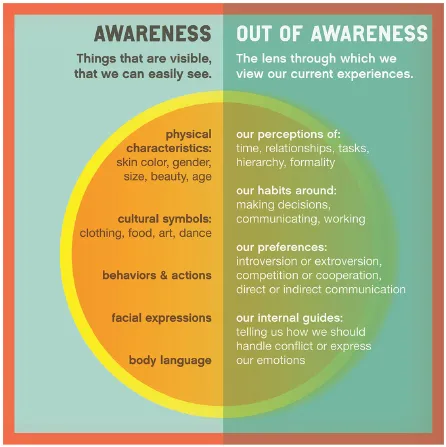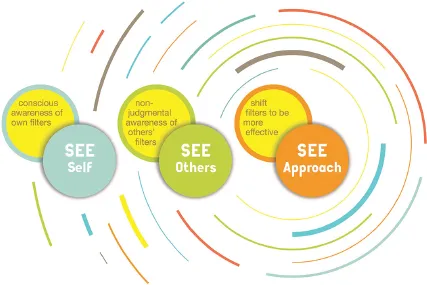![]()
Chapter One
Of Dictators, Blind Spots, and Personal Effectiveness
So what exactly happened to end the meeting between Saddam Hussein and Bill Richardson before it even began? Unconsciously filtering the situation to believe that he could be informal, Richardson settled in when he sat down for the meeting. Angled in his chair, leaning with one arm over the back, he crossed his ankle over his knee, his flexed foot pointing the bottom of his shoe toward Hussein. That was the moment Hussein pounded the table and terminated the meeting, leaving the US team baffled.
What Richardson didn’t know was that, in many Arab countries, showing the sole of your shoe is a blatant symbol of disrespect. The equivalent of this act in the United States would be an Iraqi emissary meeting with President Clinton, walking into the oval office, calmly sitting down, and flipping Clinton the bird, both middle fingers proudly raised. Just look at pictures of the Arab Spring uprisings of protests that began in 2010 throughout the League of Arab States and the surrounding areas. Image after image shows protestors in the streets screaming their disgust and waving the soles of their shoes at placards of their rulers.
By crossing his legs, he unwittingly revealed the sole of his shoe to Hussein—a gesture so obvious to those Richardson came to meet with, yet missed by him in his inability to Filter Shift.
Fortunately for Richardson, his inability to Filter Shift wasn’t fatal. It caused delays and unnecessary tension, but finally, after stressful re-negotiations, the meeting was resumed and he left having accomplished his objectives, though still unclear as to how he initially sent the meeting off in the wrong direction.
Richardson isn’t alone. …the vast majority of us aren’t cognizant of how our filters control our thoughts, behaviors, and decisions. In fact, the vast majority of us aren’t cognizant of how our filters control our thoughts, behaviors, and decisions. Unlike Richardson, our meetings are with coworkers, not dictators. Yet very much like Richardson, in those meetings our filters can misguide us.
At times, as with Richardson, our filters lead to failure for us. There are the more obvious failures: the leader whose speech to the company nosedives, the extensive marketing campaign that fails, and the merger that flops. Each failure is preceded by extensive preparation resulting in a naive confidence in the ability to perform, and followed by confusion at the unexplained source of the failure.
In these cases, the results of automatic filtering are obvious. More frequently, however, our individual failures or mishaps caused by an inability to Filter Shift aren’t on such a grand scale and are therefore much less obvious. They happen on a day-by-day, moment-by-moment basis, and we’re blind to the full spectrum of perception and belief at play, oblivious to our ineffectiveness. We leave a conversation or situation and we think we’ve communicated successfully, yet we haven’t; we think we’re effective, yet we aren’t. We have significant blind spots that leave us drastically overestimating our effectiveness.
To complicate things, when it comes to difference, we typically see only a very narrow spectrum of variables. Things that are “easier” to recognize like gender, race, and language, we see easily enough; however, while those differences are frequently important, they’re only part of a much broader spectrum of differences that tend to be outside of our awareness. When misunderstandings or conflicts arise, more often than not they are caused by the differences that we don’t see—differences obscured by our automatic filters.
Without the ability to Filter Shift, we can see very little of the full complexity of differences at play, and thus frequently misattribute misunderstandings to those few things that are in our immediate awareness, furthering the misunderstanding (see fig. 1.1).
Figure 1.1. We typically see a very narrow spectrum of difference. Only when we learn to Filter Shift can we see the full spectrum of differences.
So what can we do about this problem with our individual and collective vision? If automatic filtering of experiences is hardwired into our brains, is there anything we can do about it? How could so many of us not only be ineffective, but also unaware of that ineffectiveness? Put plainly, we just haven’t been taught anything different. We actually don’t know any better. And when the vast majority of people around us are stuck in the same cycle of automatic filtering, we not only don’t see a need for anything different, we also reinforce that filtering for each other.
False Prescriptions
When it comes to our interactions across difference—frankly, all interactions—an unconscious optometrist chooses our filters based on false prescriptions we write for ourselves. This process is completely natural; our brains are wired to react this way. Our perception of any given situation is filtered quickly and unconsciously. We don’t even realize a filter through which to view an interaction has been preselected without our conscious participation. These false prescriptions are rooted in our misconceptions of our own cultural competence. Recognizing them for what they are is an essential first step in learning to Filter Shift.
Prescription #1: I’m not around people who are different from me that much, so it’s a moot point.
Every interaction is an interaction across difference. That means we all experience this, all the time. I’m misled if I think this person is just like me because I don’t see any obvious differences between the two of us—we’re the same race, gender, age, etc. Yet we are different because our filters are different, and it is our filters that determine how we see and respond to each other. If we allow ourselves to be lulled by external similarities, we easily miss the broader spectrum.
Prescription #2: Exposure = Competence
Here we make statements like “I’m around differences all the time. I have a gay couple for neighbors, my mom has lived with a disability all my life, and my best friend is black!” The inherent belief in these statements is that “I am exposed to difference, therefore I am competent in my interactions across difference”—as if a new skillset is in the air when differences are present and all we need to do is breathe it in. The ability to interact effectively across difference, like any other complex skill, needs to be consciously developed. Think of it in comparison to developing math skills. You would never assume a child could learn math if you just sat them in a room all day where mathematicians were present. As with math, we need intentional, developmental learning and practice to nurture this skill.
Prescription #3: I get this stuff; it’s my coworkers (or spouse or neighbors) that don’t!
Most people, if asked, would say that they do pretty well interacting across difference—that they are already fairly competent. Yet the reality is that only a very small percentage of us actually are competent. This ever-present gap between our perception and reality leads to much of the confusion and conflict that happens as we interact across difference. If I believe I “get it” and still experience situations where interactions with others are ineffective, then it must be their issue.
Prescription #4: Identity = Competence
This prescription is particularly tricky in that, while widely believed, it goes unspoken more often than not. It’s the notion that people from marginalized groups—especially people of color and women—are somehow more skilled at interacting across difference, that somehow the experiences tied to our identity inherently increase the reality of our perceptions. In actuality, that’s simply not the case. Going back to the second prescription, we need to deliberately develop the ability to Filter Shift, no matter our cultural origins or identity.
Prescription #5: I’m colorblind!
This comment is typically heard as an individual is trying to frame him/herself as a generally good person. The assumption is that only bad people have biases while in actuality we all have biases. Biases are morality-neutral. They’re a natural product of our brains working to categorize and make sense of the world for us. Eliminating bias is an unattainable goal. Instead, to be more effective, we need to recognize and understand our biases and their impact on how we see and operate. We can only do that by acknowledging that we have biases in the first place.
Prescription #6: Comfort = Competence
We’ve all felt discomfort at one point or another in our lives as we have encountered difference. It may have been the first time we ate dinner at a friend’s house, or the first time we walked into a new workplace, new neighborhood, or new country. The fallacy here comes when we believe that as the discomfort dissipates, a generalized competence somehow materializes. However, just because we’ve become comfortable in a particular situation, or with a particular person, doesn’t mean we’ve learned how to be effective outside of that single situation or with anyone other than that particular individual.
Learning to Filter Shift
Our unconscious mind snaps filters into place so fast it feels natural to see things the way we do. The judgments we make (based on what we see) feel “right,” “correct,” “good,” “obvious.” However, as demonstrated above, we’re not seeing clearly. Our automatic filters are limiting the spectrum of difference we perceive while presenting the illusion of clarity. At first glance this problem can seem overwhelming. I mean, what can we possibly do about a process we don’t consciously perceive happening? How do we see beyond these false prescriptions?
The answer is surprisingly simple—though please note I said simple, not easy. We learn how to Filter Shift. Filter Shifting is the ability to SEE Self, SEE Others, and SEE an effective approach. We train ourselves first to clearly see our own filters, then to recognize the situations in which they’re likely to be used, and finally, to consciously shift those filters, opening our eyes bit by bit to the whole available spectrum of difference (see fig. 1.2). When we’re aware of how our unconscious mind filters and decides things for us, then we can also begin to see the complexity of filters that are at play in the unconscious minds of those with whom we are interacting, and respond effectively to the richness of that complexity.
Figure 1.2. Filter Shift: SEE Self, SEE Others, SEE Approach
SEE Self, SEE Others, SEE Approach. You may have noticed the capital letters of SEE in the Filter Shift steps. That’s not just because I like the word see—which I do—or because what we see and pay attention to is important as we learn to Filter Shift—which it is. SEE is actually an acronym for See, Explain, and Evaluate (see fig. 1.3). We’ll discuss this further in chapter eight.
Figure 1.3. SEE helps us understand our three levels of observation: See, Explain, and Evaluate.
Think Wine
To better understand this ability to Filter Shift, I like to use wine as an analogy—specifically, our ability to distinguish differences in wine. While ...



